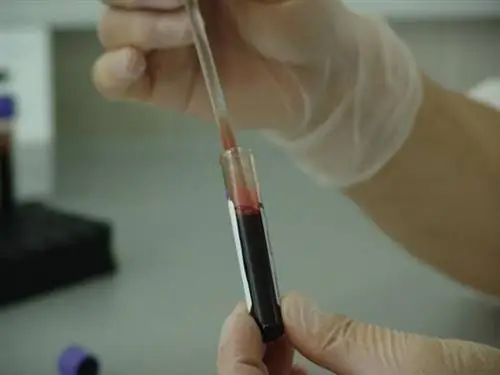- Author Carl Johnson [email protected].
- Public 2023-12-16 06:19.
- Last modified 2025-01-23 08:59.

Toxoplasmosis is a disease caused by a parasite from the group of protozoa called Toxoplasma gondii. This parasite affects many warm-blooded animals, including humans. However, the definitive host is always felines. It generally does not cause clinical signs, but when they do occur they are a consequence of the necrosis processes produced by the parasite in various tissues. Therefore, it can cause various signs, such as digestive, respiratory, ocular, cardiac, cutaneous, muscular and nervous. In pregnant cats it can cause neonatal deaths or premature births and newborn kittens with toxoplasmosis can die shortly after birth.
Keep reading this article on our site to learn more about feline toxoplasmosis, its symptoms, diagnosis and treatment In addition, a final section in relation to the frequent problems among pregnant women who have a cat at home, informing about the measures to take to avoid the risk of infection.
What is toxoplasmosis in cats?
Toxoplasmosis is a parasitic disease caused by a protozoan called Toxoplasma gondii, an obligate intracellular parasite that affects various warm-blooded animals, including the human being. However, the definitive host of the parasite is the feline, which can transmit the disease by shedding oocysts into the environment.
Oocysts are the source of infection of the parasite and are the result of the sexual division of the parasite that occurred in the infected feline. They are like a kind of eggs that the parasite eliminates to the environment to infect other animals. Inside they contain sporozoites, which are crescent-shaped, single-celled, mobile organisms.
Cats shed millions of oocysts in their feces up to 3 weeks after exposure to the parasite, which require 1 to 5 days to sporulate and become infective to other animals (sporulated oocysts).
In addition to oocysts, we can find:
- Pseudocysts containing tachyzoites (rapidly multiplying zoites) located in muscle tissue, nerves, retina, etc.
- Cysts containing bradyzoites (slowly multiplying zoites) located mainly in the musculature, but also in the central nervous system or other organs.
Toxoplasmosis infection in cats
The transmission routes of feline toxoplasmosis are as follows:
- Ingestion of infected raw meats or food contaminated with infective oocysts.
- Ingestion of food or water contaminated with oocysts.
- Transplacental during gestation.
- Lactation.
- Blood transfusion.
Toxoplasma gondii life cycle
The cycle of this protozoan parasite can be direct when it is carried out between cats and an enteroepithelial and extraintestinal cycle is developed; and indirect when between cats another animal intervenes as an intermediate host, developing only the extraintestinal cycle.
- Enteroepithelial cycle of Toxoplasma gondii: occurs only in cats after ingesting cysts, either by ingestion of prey, viscera or meat raw. After ingestion, the digestive enzymes break it down and the bradyzoites come out and penetrate the intestinal cells where they carry out a sexual division and form non-sporulated oocysts that they will eliminate in the feces. This cycle can also occur if they ingest pseudocysts or oocysts, but it is not as fast or as effective.
- Toxoplasma gondii extraintestinal cycle: occurs in cats and animals that become parasitized after ingestion of sporulated oocysts in water or contaminated food, as well as pseudocysts or cysts. In this case, the parasite targets the lamina propria of the intestinal cells where asexual reproduction takes place, giving rise to tachyzoites that are distributed throughout various parts of the animal's body with their rapid multiplication, causing cell death (necrosis).
Symptoms of toxoplasmosis in cats
Although toxoplasmosis in cats is usually asymptomatic, that is, it does not produce symptoms in cats, it can sometimes cause symptoms, especially in cats affected for the first time or after reactivations of parasite latency.
Depending on where the parasite is headed, the clinical signs will vary. Thus, we can divide the symptomatology depending on the place of action, so that we can find digestive, ocular, respiratory, cardiac, nervous, skin and muscle signs. Next, we will help you discover how to know if a cat has toxoplasmosis through its symptoms:
Digestive signs
In these cases, toxoplasma targets digestive organs such as the liver, stomach, pancreas and intestine, and can cause clinical signs such as:
- Anorexy.
- Diarrhea.
- Vomiting.
- Hepatic necrosis and enlarged liver.
- Cholangiohepatitis.
- Jaundice.
- Abdominal pain.
- Peritoneal and abdominal effusion.
- Pancreatic and intestinal necrosis.
Ocular signs
The eye can also be invaded by toxoplasmosis in cats, where it attacks the retina, uvea and optic nerve, causing symptoms What:
- Anterior and posterior uveitis.
- Vasculitis.
- Optic nerve neuritis.
- Chorioretinitis.
- Iridocyclitis.
- Glaucoma.
- Decreased pupillary response to reflexes.
When only ocular toxoplasmosis appears, without any other signs of involvement of other organs, it may be indicative of immunosuppression and reactivation of the parasite.
Respiratory signs
When the parasite targets the lung, it can cause pneumonia with:
- Fever.
- Respiratory difficulty.
- Pleural effusion.
- Increased respiratory rate (tachypnea).
Cardiac signs
When it multiplies in the cells of the heart, it leads to myocardial insufficiency which will eventually lead to dilated cardiomyopathy and signs of heart failure, such as tachycardia, tachypnea, and pleural effusion with severe respiratory failure, depression, and collapse.
Nervous signs
More than 95% of cats with toxoplasmosis have neurological symptoms such as:
- Seizures.
- Tremors.
- Ataxia.
- Behavioral alterations.
- Paresis.
- Stupor.
- Cerebellar or vestibular signs.
- Partial or total blindness.
- Walking in circles.
In the same way as ocular toxoplasmosis, toxoplasmosis in cats with neurological symptoms without any other clinical signs usually appears as reactivation of the diseaseThis is because the central nervous system is the tissue where the parasite is latent in greater proportion.
Skin signs
It can sometimes affect the skin, resulting in firm nodules on the extremities due to Nodular pyogranulomatous dermatitis. Also occurs vasculitis and necrotizing dermatitis.
Muscular signs
When the parasite targets the cat's musculature, it causes the following clinical signs:
- Rigidity.
- Muscle atrophy.
- Altered gait.
- Muscle pain.
- Neck ventroflexion due to polymyositis.
- Polymyositis and polyradiculoneuritis causing paraparesis or spastic paraplegia.
Toxoplasmosis in pregnant cats and kittens
When a pregnant cat is infected with Toxoplasma gondii, she has not been previously exposed to this parasite and therefore does not have antibodies, the infection can cause premature birthsor deaths in newborn kittens.
On the other hand, newborn kittens that were infected transplacentally or during lactation are at greater risk of producing severe toxoplasmosis, and can be stillborn or die within the first days of life In other cases, when they are born they seem he althy, but later they develop depression, hypothermia, lethargy, very frequent meowing, encephalitis and in some cases, death.
Those that survive remain latent carriers, and the infection may be reactivated in the face of certain stressful and immunosuppressive conditions, frequently causing nervous or ocular toxoplasmosis.
Diagnosis of toxoplasmosis in cats
The diagnosis of feline toxoplasmosis is complex, requiring several tests to complete it. These tests include a blood test, diagnostic imaging, serological and molecular tests.
- Blood test: In blood biochemistry, during the acute phase of the disease, increases in alkaline phosphatase, ALT and bilirubin in cats with liver involvement, increased creatine kinase (CK) in cases of muscle necrosis, and elevated fPLI in cases of pancreatitis due to pancreatic necrosis.
- Chest x-ray: When pulmonary signs are present, a diffuse alveolar and interstitial pattern may be seen in the lung or mild pleural effusion.
- Abdominal x-ray: liver enlargement and ascites.
- Ultrasound: allows a better visualization of the abdominal organs and their parenchymal lesions.
- Computerized tomography or magnetic resonance imaging for the detection of lesions in the central nervous system.
- Serological tests: such as ELISA for the detection of immunoglobulins (antibodies) G and M (IgG and IgM). When an increase in both is seen in a cat with symptoms, it indicates active infection or reactivation. If only IgG is increased in a he althy cat, it has latent toxoplasmosis.
- PCR for Toxoplasma gondii: This is the most specific test for diagnosis. The samples can be blood or ocular aqueous humor, cerebrospinal fluid or brain. However, when detecting the genetic material, it does not differentiate an active disease from a latent one, simply that it is positive for toxoplasma.
- Biopsy: This is the test that confirms the diagnosis, although it is the most invasive. Demonstrates the presence of the parasite in the cells.

How to eliminate toxoplasmosis in cats? - Treatment
Treatment for toxoplasmosis in cats is based on symptomatic and pharmacological therapy with antibiotics that will inhibit the multiplication of toxoplasma, but not his death.
Today, the antibiotic of choice is clindamycin at a dose of 12.5 mg/kg every 12 hours for a month, applied intramuscularly or orally. This treatment resolves the cat's symptoms 24-48 hours after onset, but it is not effective when the lesions in the central nervous system are permanent. Likewise, it takes longer to resolve muscle atrophy and polymyositis in cases of muscular toxoplasmosis.
In cats with neurological toxoplasmosis, trimethoprim-sulfonamide or doxycycline is used for 1 month, as it can cross the blood-brain barrier.
Uveitis in cases of pulmonary toxoplasmosis is treated with topical, systemic corticosteroids or non-steroidal anti-inflammatory drugs for at least 1 month and cycloplegic drugs such as atropine or tropicamide. The latter should not be used in cases of glaucoma due to increased intraocular pressure that would aggravate the process and use dorzolamide or brinzolamide 3 times a day.
Toxoplasmosis in cats and pregnancy
The concern and lack of information about feline toxoplasmosis and pregnancy in women is a common problem even today. Having a cat at home and being pregnant are not incompatible, it is simply necessary to establish some preventive hygienic measures to avoid the risks that, although low or almost non-existent, can occur.
Below, we give all the information so that they don't deceive you and much less make you avoid being with your feline companion in this very special process. The preventive measures that pregnant women should have when feeding and handling the cat litter box are:
- Avoid eating raw meat and sausages as they may be contaminated with Toxoplasma gondii oocysts.
- Do not eat unwashed fruits and vegetables as they may be contaminated by oocysts.
- Clean and handle the cat's litter box with gloves and wash your hands afterwards, or, if possible, have someone else do it family member. Feces are the source of infection for feline oocysts as they are released and sporulated in the feces between 24 hours and 5 days later.
As we can see, contagion is not caused by caressing or being in contact with a house cat, but the parasites need to spend a few hours in a substrate such as food or cat feces to be infective and transmit the infection. illness.
However, many women have Toxoplasma gondii antibodies due to having had close contact with outdoor cats since childhood, so they would have defense. Even so, it is advisable to always take hygienic measures to avoid abortions, failures in growth or formation and problems in the future baby.
How to avoid toxoplasmosis in cats
Toxoplasmosis infection in our cats can be avoided by taking the following measures:
- They should be prevented from hunting if they are cats that go outside.
- Drinking from uncontrolled or dirty places should be avoided.
- It is recommended not to give them raw or undercooked meat. If you want to give them meat, it must be cooked at 60ºC for 10 minutes or frozen at -20ºC.
- It is advisable to feed them commercialized cat food. If you want to establish a BARF diet, you must take into account the above measures or buy food from brands that are dedicated to the preparation of these diets.
- They should avoid eating sausages or vegetables.
If you want your cat to enjoy a homemade diet, don't miss this video to keep feline toxoplasmosis at bay:






